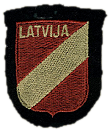CIA recruits émigrés, pays handsomelyat page 98
Hāzners appears next as a CIA operative.
The CIA sponsored [entry into the United States] and helped pay the salary of Vilis Hāzners, who had served in the Latvian Schutzmannschaft in 1941 in Riga and allegedly participated, among other atrocities, in helping to push Jews into a burning synagogue. After his arrival in the United States through the Refugee Relief Act, he took the chairmanship of the Committee for a Free Latvia and became a delegate to the Assembly of Captive European Nations (ACEN) in New York. The CIA funneled money to such anti-communist émigré organizations, which helped to pay Hāzners's salary in the amount of about $12,000 per year in the 1950s. In addition, Hāzners was a member and chairman of the Latvian Officers Association, made up mostly of former Waffen-SS members, and other Latvian refugee groups. As such he supported an open appeal to the United Nations (UN) to finally deal with “Soviet colonialism” in the Baltic states on the 25th anniversary of the Soviets’ occupation of Latvia in 1965.a
a Simpson, Blowback, 205–6; New York Times, June 15, 1965, 6.
Sources
Christopher Simpson | pages 205–6
We review Simpson's allegations against Latvians including his denunciations of Hāzners at length in our detailed review of Simpson's Blowback.
Summarizing:
- CIA sponsored Hāzners to enter U.S.—FALSE, per declassified CIA files
- CIA helped pay Hāzners's salary—true, up to $300 per quarter for assistance with interviews, translations, etc., but not guaranteed; potentially $4,800 annually as "overt" salary heading anti-Soviet efforts, per declassified CIA files;
- CIA paid Hāzners $12,000 per year—FALSE, per declassified CIA files;
- Hāzners served in the Schutzmannschaft—FALSE, at the time alleged Hāzners served in the Selbtschutz; neither Simpson nor the New York Times article mention the Schutzmannschaft; this is Schiessl's error;
- Hāzners herded Jews into a burning synagogue—FALSE;
- Hāzners served as chairman of the Committee for a Free Latvia and delegate to the Assembly of Captive European Nations (ACEN)—true;
- anti-Soviet activism—true, which "activism" Simpson attempts to fashion into a cynical CIA Cold War conspiracy in which the U.S. government knowingly recruited Nazi war criminals.
 | In his book, Simpson believes anyone who wore a German uniform is a Nazi, ridicules "the myth that the Baltic Waffen-SS legions were simply anti-Communist patriots," and features KGB propaganda in his "selected bibliography." Blowback embodies neither scholarship nor legitimate investigative journalism. |
After Schiessl published his thesis, but well before publishing his book, Simpson even appeared on the Kremlin's propaganda cable television channel to denounce Latvians as Nazis and Nazi-glorifiers.
New York Times | June 15, 1965
Excerpted from "Some Suspected of Nazi War Crimes Are Known as Model Citizens" by Ralph Blumenthal:
Those [accused of being Nazis] who came under official investigation might never have been known publicly except for the fact that the Immigration Service, in response to some charges of foot-dragging on the Nazi cases, released the names of 37 suspects in June 1974.
...
Vilis Hāzners, a 71-year-old Latvian who came here in 1956 as an avowed displaced person from Germany. He has been under investigation regarding allegations of atrocities by Latvian Police. He is the former president of the Committee for a Free Latvia in Washington and delegate to the Assembly of Captive European Nations. He is now living on a well kept 104-acre farm near Whitehall, N.Y., close to the Vermont border.
In a recent telephone interview he said he had been a major fighting with German forces on the Eastern Front but declined to discuss the allegations directly, referring further inquiries to his attorney, Ivars Berzins, who also refused to comment on the charges.
The INS's "list of names" can be traced back to Soviet propaganda. While Simon Wiesenthal had, for example, "identified" Hāzners as a "criminal" to authorities in 1949 based on a search for Waffen-SS officers, the INS was working on a Wiesenthal list from 1973 and from Soviet propaganda naming Hāzners.
 | The cited New York Times article corroborates some facts on which Simpson was correct. Otherwise it, and its mention of the list of names, does not feature in Schiessl's narrative. |
